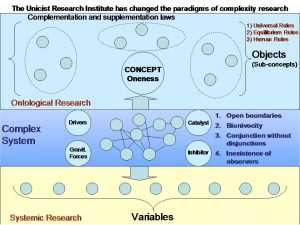 The unicist theory expanded the frontiers of sciences making the scientific approach to complex adaptive systems possible without needing to use arbitrary palliatives to transform complex systems into systemic systems in order to be able to research them.
The unicist theory expanded the frontiers of sciences making the scientific approach to complex adaptive systems possible without needing to use arbitrary palliatives to transform complex systems into systemic systems in order to be able to research them.
Paradoxically this is a breakthrough and a back to basics. On the one hand it is a breakthrough because it changed the paradigms of scientific research. On the other hand it is a back to basics because it drives sciences to deal with the nature of reality.
The unicist logical approach opened the possibilities of managing complexity sciences using a pragmatic, structured and functionalist approach:
https://www.unicist-school.org/complexity-sciences/wp-content/uploads/2013/04/standard_unicist_approach_en.pdf
The unicist approach to complexity is based on the research of the unicist ontological structure of a complex adaptive system which regulates its evolution. This is based on emulating the structure of the unicist ontogenetic intelligence of nature considering that every functional aspect of reality has a unique unicist ontological structure.
www.unicist.org/deb_ute.php
The approach to ontological structures of reality requires going beyond the dualistic thinking approach and being able to use the double dialectical logic to approach complex adaptive systems.
www.unicist.net/clipboard/
The research in complexity science needs to have its own format for its presentation that has a structural difference with the papers for systemic sciences (abstract, introduction, materials and methods, discussion, literature). It has to be considered that:
1) A complex system has open boundaries which implies that the experiences cannot be reproduced they can only be emulated in homologous fields.
2) Having open boundaries there is no possibility of building artificial experiences to research a complex adaptive system.
3) As it has open boundaries it cannot be observed. The observers are part of the system. This implies that a peer review can only be made based on the use of destructive tests in homologous fields.
4) The conditions of the environment change, (No one can bathe twice in the same river – Heraclitus) which means that an apparently same experience might produce different results.
5) The elements of a complex adaptive system are integrated by the conjunction “and” with multiple bi-univocal relationships. Therefore there are no univocal cause-effect relationships; this implies that the only valid measurable aspects are the results obtained.
6) Predictions of results and measurement of the achievements are the way the validity of the knowledge of the structure of a complex adaptive system is confirmed.
7) The discussions with other opinions are meaningless because complex adaptive systems have open boundaries and only its application allows confirming the knowledge obtained.
8) Multiple real applications in different homologous and analogous fields, preceded by a prediction of the results that will be obtained, need to be done to confirm the knowledge of a complex adaptive system.
9) The method of the research is in the application itself which has to correspond to the field of activity of the complex adaptive system.
The research work
As researchers are part of any complex adaptive system that is being researched, a unicist reflection process is needed to develop the process. This implies a full involvement of the researcher in the system following an action-reflection-action process to find the unicist ontological structure that regulates the evolution of the complex adaptive system.
The presentation of the knowledge of complex adaptive systems includes two different levels of information:
a) The abstract: which includes the discoveries of the unicist ontological structures and the ontogenetic maps written in unicist standard language
b) The research process: which describes the research process
The basic steps of the research process are:
1) Develop the hypothetical structure of the ontology.
2) Analyze the ontology and divide it into sub-ontologies following the laws of complementation and supplementation (only when necessary and possible).
3) Define observable results that need to be considered to validate the ontology.
4) Define the application fields of the ontology to validate its functionality.
5) Develop the applications beginning with destructive and non-destructive pilot tests to forecast reality.
6) Develop at least five experiences in the application field differing completely one from the other.
7) Develop forecasts of at least three periods with full certainty.
8) Restart the research process every time a deviation occurs.
Conclusion
It becomes evident that the field of researching complex adaptive systems is for doers, who assumed the responsibility for results and have the necessary inner freedom to emulate in mind adaptive systems that are in motion. The use of the knowledge does not require knowing how it was produced.
Peter Belohlavek
NOTE: The Unicist Research Institute was the pioneer in complexity science research and became a private global decentralized world-class research organization in the field of human adaptive systems. http://www.unicist.org
 Everyone considers that s/he has the concept of what they are doing.
Everyone considers that s/he has the concept of what they are doing.









